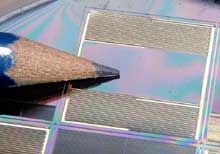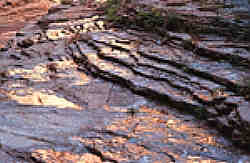
UC Berkeley scientist urges drilling into frozen lake under ice near South Pole as prelude to drilling into subglacial lakes in Antarctica and into Mars polar caps
Measurements of the ice temperature far below the South Pole suggest that a so-called “lake” discovered at the base of the ice is most likely permafrost – a frozen mixture of dirt and ice – because the temperature is too low for liquid water.
Far from being a disappointment, says a University of California, Berkeley p

Capping two years of research, a nationwide group of over 100 scientists has created a powerful new computer model of the Earth’s climate. The model surpasses previous efforts by successfully incorporating the impact of such variables as ocean currents and changes in land-surface temperatures.
Researchers will use the model, called CCSM-2 (Community Climate System Model, version 2) to probe how our climate works and to experiment with “what-if” scenarios to predict what our climate may be l

There is high temperature inside our planet and the reason is not known yet. A common belief that the Earth`s interior is heated by radioactive elements is now doubted of. Professor Felix Letnikov from Irkutsk Institute of the Earth`s Crust have proposed an idea that the heat is formed in the outer core because of friction between its layers.
Different geophysical data confirm that there is a heat source inside the Earth. In the mantle there are zones with low viscosity, which corre

A team of Ohio State University researchers has returned from an expedition in southeastern Alaska with the longest ice core ever drilled from a mountainous glacier.
The core measures 460 meters (1,509 feet) and is 150 meters (492 feet) longer than the previous longest core – a record of ice from the Guliya ice cap in western China that eventually relinquished a climate record stretching back 760,000 years – the oldest such record retrieved to date.
Until the new core is analyzed in

Arantxa Aranburu, doctor of the University of the Basque Country and lecturer of the Department of Geology, has proved that the bones of Homo heidelbergensis found in Sima de los Huesos, Atapuerca, are even older than thought.
In the gallery of Sima de los Huesos, Atapuerca, a speleothem was found during a stonecutting, over the bones of the ancestors of the Neanderthals, the Homo heidelbergensis . Speleohtem is a carbonate precipitate, that is, it is made of the same material

Rensselaer Polytechnic Institute Professor Part of International Research Group Refuting Popular Theory
In 1996, marine geologists William Ryan and Walter Pitman published a scientifically popular hypothesis, titled Noah’s Flood Hypothesis. The researchers presented evidence of a bursting flood about 7,500 years ago in what is now the Black Sea. This, some say, supports the biblical story of Noah and the flood.
But, such a forceful flood could not have taken place, says

University at Buffalo scientists working with ice cores have solved a mystery surrounding sunspots and their effect on climate that has puzzled scientists since they began studying the phenomenon.
The research, published in a paper in the May 15 issue of Geophysical Research Letters, provides striking evidence that sunspots — blemishes on the sun’s surface indicating strong solar activity — do influence global climate change, but that explosive volcanic eruptions on Earth can complet

A study of the ancient Mediterranean Sea will help to produce more accurate predictions of climate change.
A team led by Royal Holloway geologist Dr Michal Kucera will map sea-surface temperature of the Mediterranean over past millennia. The data will provide a new target to test the computer models on which our predictions of climate change are based.
We currently make climate change predictions using mathematical models developed using climate records of the last two centuries. T

New measurements show that the flow of ice in the Greenland ice sheet has been accelerating since 1996 during the summer melt season. The results suggest that the ice sheet may be responding more quickly to the warming climate than previously thought.
In an article published in Science magazine’s online Sciencexpress June 7, Jay Zwally, an ICESat Project scientist at the NASA Goddard Space Flight Center, Greenbelt, Md., Waleed Abdalati, a Polar Program scientist at NASA Headquarters, W

While industrial products like chlorofluorocarbons are largely responsible for current ozone depletion, a NASA study finds that by the 2030s climate change may surpass chlorofluorocarbons (CFCs) as the main driver of overall ozone loss.
Drew Shindell, an atmospheric scientist from NASA’s Goddard Institute for Space Studies (GISS) and Columbia University, N.Y., finds that greenhouse gases like methane and carbon dioxide are changing the climate in many ways. Some of those effects include wat

The catastrophic flooding in Jakarta in February this year could have been predicted nearly 3 weeks in advance with a new technique being developed by Dr Matt Wheeler and colleagues at the Bureau of Meteorology Research Centre in Australia.
The flooding was caused by large waves of air and clouds, so called Madden-Julian Oscillations (MJOs). Using satellite data Dr Wheeler and co-workers are able to predict the occurrence of MJOs, which take about one month to move across the Indian basin a

A shower of matter from space millions of years ago could have led to drastic changes in the Earth’s climate, followed by the extinction of life on a massive scale, which also killed off the dinosaurs. This at least is a theory put forward by scientists from the University of Bonn. Normally, the solar wind acts as a shield against showers of cosmic particles, which prevents too many energy-rich particles from raining down on our atmosphere. Since 1997 scientists from Bonn, funded by the German Resea

The results of a new study suggest that rising temperatures are leaving a mark on the world. According to a report published in the current issue of the journal Science, the first flowering of plants in Britain has changed by as much as 55 days over the past few decades in response to warmer weather. The results, the scientists say, are the “strongest biological signal yet of climatic change.”
Alastair Fitter of the University of York and his father, naturalist Richard Fitter, analyzed 47 y

Researchers at Imperial College London have just begun a 5-year project to design and build tiny earthquake measuring devices to go to Mars on the 2007 NetLander mission.
Unlike the instruments on next year`s European Mars Express/Beagle II mission, the Marsquake sensors will be the first to look deep inside the planet.
The internal structure of Mars is a key to understanding some fundamental questions about the planet including whether life ever existed there.
The sensors are c

Scientists at the University of Leicester’s Space Research Centre are recreating the hostile environment found on Mars in their laboratory, with a device known as the Martian Environment Simulator (MES). The machine reproduces the temperature, air pressure and unbreathable atmosphere known to exist on Mars. The MES is currently being used to test equipment on the Beagle 2 lander, part of the European Space Agency’s Mars Express Spacecraft and due to arrive on Mars during Christmas 2003. The chance o

Gold prospectors may one day rely on lowly bacteria to point them to deposits of the precious metal. Researchers have discovered that gold-laden soil often contains an abundance of spores belonging to a certain bacterium. The affinity humans have for gold aside, the ore in its soluble form is actually highly toxic to most living things. The common bacterium Bacillus cereus , however, possesses a unique resistance to the metal, allowing it to survive in a relatively vacant environmental niche: